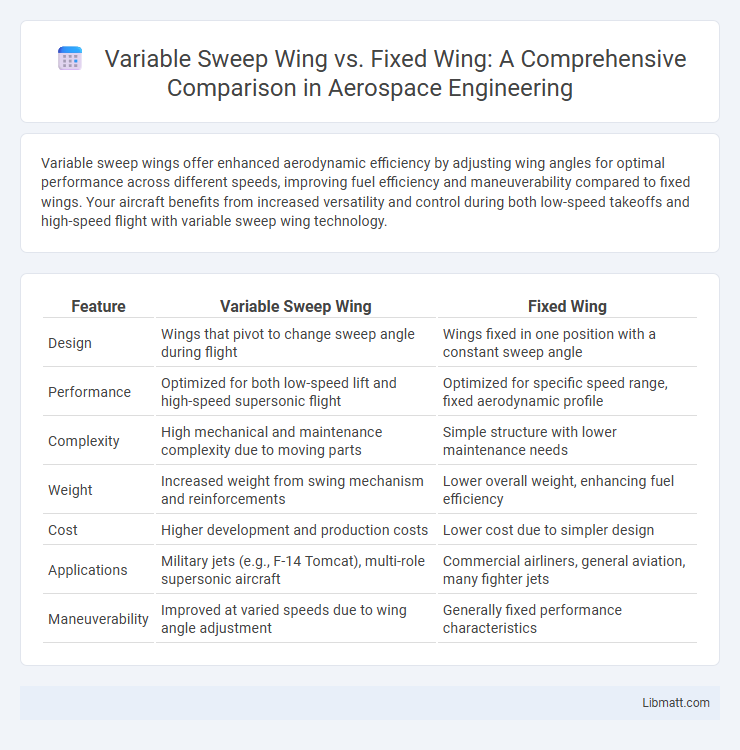Variable sweep wings offer enhanced aerodynamic efficiency by adjusting wing angles for optimal performance across different speeds, improving fuel efficiency and maneuverability compared to fixed wings. Your aircraft benefits from increased versatility and control during both low-speed takeoffs and high-speed flight with variable sweep wing technology.
Table of Comparison
| Feature | Variable Sweep Wing | Fixed Wing |
|---|---|---|
| Design | Wings that pivot to change sweep angle during flight | Wings fixed in one position with a constant sweep angle |
| Performance | Optimized for both low-speed lift and high-speed supersonic flight | Optimized for specific speed range, fixed aerodynamic profile |
| Complexity | High mechanical and maintenance complexity due to moving parts | Simple structure with lower maintenance needs |
| Weight | Increased weight from swing mechanism and reinforcements | Lower overall weight, enhancing fuel efficiency |
| Cost | Higher development and production costs | Lower cost due to simpler design |
| Applications | Military jets (e.g., F-14 Tomcat), multi-role supersonic aircraft | Commercial airliners, general aviation, many fighter jets |
| Maneuverability | Improved at varied speeds due to wing angle adjustment | Generally fixed performance characteristics |
Introduction to Variable Sweep Wing and Fixed Wing Designs
Variable sweep wing designs allow aircraft to adjust wing angles dynamically during flight, optimizing performance for different speeds and maneuvers, while fixed wing designs maintain a constant wing shape that provides stability and simplicity. The variable sweep wing offers versatility in aerodynamics, enhancing fuel efficiency and handling across varied flight conditions compared to the fixed wing, which excels in structural integrity and cost-effectiveness. Your choice depends on mission requirements, balancing adaptability with manufacturing and maintenance considerations.
Historical Development and Evolution
Variable sweep wing technology originated in the mid-20th century to enhance aircraft performance across various flight regimes, first implemented notably in the F-111 Aardvark and later refined in the F-14 Tomcat. Fixed wing designs, rooted in early aviation, evolved through gradual aerodynamic improvements focusing on stability and efficiency but remained limited in adaptability to speed variations. The shift towards variable sweep wings marked a revolutionary approach, allowing aircraft to optimize lift and drag characteristics dynamically, a crucial advancement during the Cold War era to balance high-speed supersonic flight and low-speed handling.
Aerodynamic Principles Compared
Variable sweep wings adjust their angle to optimize lift and drag across different flight speeds, improving aerodynamic efficiency in both low-speed takeoff and high-speed cruise. Fixed wings maintain a constant angle, offering simpler design and stable low-speed handling but less versatility in controlling aerodynamic forces. Your aircraft's performance can benefit from variable sweep by dynamically balancing lift and drag through changing wing geometry.
Design Complexity and Engineering Challenges
Variable sweep wings require intricate mechanical systems and advanced control mechanisms to adjust wing angles during flight, significantly increasing design complexity compared to fixed wings. Engineering challenges involve ensuring structural integrity under variable loads, managing weight distribution, and maintaining aerodynamic efficiency at diverse sweep settings. Your choice between variable sweep and fixed wing designs depends on balancing these complexities with desired aircraft performance.
Performance Across Different Speeds
Variable sweep wings optimize your aircraft's aerodynamics by adjusting wing angles to enhance performance across a wide range of speeds, improving lift during low-speed takeoff and landing while reducing drag at high speeds. Fixed wings provide stable, efficient performance optimized for a specific speed range but lack adaptability, resulting in compromised efficiency outside that range. Variable sweep technology offers superior versatility, especially for military jets requiring rapid transitions from subsonic to supersonic speeds.
Fuel Efficiency and Operational Costs
Variable sweep wings enhance fuel efficiency by adjusting wing geometry for optimal performance across different flight speeds, reducing drag during cruise and improving lift during takeoff and landing. This adaptability leads to lower operational costs through decreased fuel consumption and extended airframe life, despite higher initial manufacturing and maintenance complexities compared to fixed wing designs. Fixed wings offer simplicity and lower upfront costs, but their less efficient aerodynamics at varying speeds result in higher fuel usage and operational expenses over time.
Applications in Military and Civil Aviation
Variable sweep wings offer enhanced aerodynamic performance by adjusting wing sweep angles, making them ideal for military aircraft requiring both high-speed supersonic flight and low-speed maneuverability, such as the F-14 Tomcat. Fixed wings provide structural simplicity and fuel efficiency, favoring civil aviation where predictable, stable flight and lower maintenance costs are priorities, commonly seen in commercial airliners like the Boeing 737. Your choice between these wing types depends on mission requirements, balancing versatility against operational economy.
Maintenance and Durability Considerations
Variable sweep wings require more complex maintenance due to their intricate pivot mechanisms and hydraulic systems, increasing inspection frequency and part replacements compared to fixed wings. Fixed wings offer superior durability with fewer moving parts, resulting in lower long-term maintenance costs and enhanced structural integrity under diverse flight conditions. The trade-off between adaptability in variable sweep wings and the simplicity and robustness of fixed wings significantly impacts maintenance strategies and operational longevity.
Notable Aircraft Examples: Case Studies
The F-14 Tomcat exemplifies the effectiveness of variable sweep wings, allowing it to optimize performance for both supersonic speeds and carrier landings. In contrast, the F-16 Fighting Falcon's fixed wing design emphasizes agility and simplicity, excelling in dogfights and multirole missions. Your aircraft design choice depends on mission requirements, balancing the complexity and versatility of variable sweep wings against the reliability and aerodynamic consistency of fixed wings.
Future Prospects and Emerging Technologies
Variable sweep wing technology offers enhanced aerodynamic adaptability, promising improved fuel efficiency and maneuverability in future aircraft designs. Emerging technologies such as advanced composites and smart materials enable more reliable and lighter variable sweep mechanisms, expanding their operational lifespan and performance. Fixed wing designs continue to evolve with innovations in laminar flow control and blended wing-body configurations, focusing on minimizing drag and maximizing structural efficiency for next-generation commercial and military aircraft.
Variable Sweep Wing vs Fixed Wing Infographic

 libmatt.com
libmatt.com